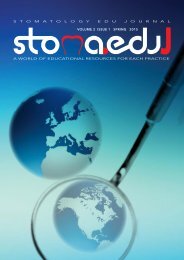Stomatology Edu Journal 1/2014
You also want an ePaper? Increase the reach of your titles
YUMPU automatically turns print PDFs into web optimized ePapers that Google loves.
Editorial<br />
Why Peer Review?<br />
Jean-Francois Roulet<br />
DDS, PhD, Prof hc<br />
Professor<br />
University of Florida, Gainesville, FL, USA<br />
Dear Readers,<br />
As dentists we are part of the medical community. We are the experts in everything related to the health of<br />
the oral cavity and its surroundings. Therefore ethical guidelines require us to deliver treatment or provide<br />
advice of the highest quality for the benefit of our patients. This sounds great; however it includes an inherent<br />
conflict: how to define quality. This is very difficult in medicine and dentistry. Quality may be divided into<br />
process quality (in simple terms: do the right thing) and outcome quality (in simple terms: do it right). Both<br />
need definitions, what is good or bad; and this is where the problem sits.<br />
Once upon a time our teachers were setting the requirement for what is considered good quality, often based<br />
on their opinion, and we students had to comply. These days things got more complicated. We need to base our<br />
definitions on facts or results based on experiments. For dental care and medicine the ultimate measurement<br />
of good quality is the survival of the restoration or the patient after an intervention or therapy. “Evidence<br />
based” is the magic word here. However we cannot base all our doing only on results of clinical studies, as we<br />
would postpone good treatment options to our patients for years. Therefore we need to accept lower evidence<br />
levels such as in vitro studies as well, to make up our mind.<br />
In the age of the internet information is available instantaneously and globally, which is a very good thing. The<br />
back side of this is the information overload and the black side is that the average user cannot distinguish<br />
anymore which information is relevant or true, or which information is pure claim or just intended to motivate<br />
the target reader to use it, or to use the product described. This is where peer review becomes important.<br />
Anders Linde, the Editor of the European <strong>Journal</strong> of Oral Sciences once stated: “Nothing is scientifically<br />
shown or proven before it has been published in a scientific journal with a peer review system, so one<br />
can critically judge what was done, how it was done and evaluate how solid it is.” The application of<br />
this by an editorial team means that a group of experts in the field (the peers) will have very carefully<br />
looked at every document which is finally published. They will check if the information provided is new,<br />
if the formatting is correct, if the language is used correctly, if the methods used make sense and are<br />
free of bias. Statisticians will look at the results to make sure that the outcome is really a function of the<br />
experimental variables. The experts will also ask themselves “Does it make sense?” and will critically<br />
look at results which may significantly differ from other similar tests. Finally, the editorial team will<br />
make sure that the conclusions drawn are strictly related to the outcome of the experiments. If there<br />
are questions, which is almost always the case, then the authors are challenged to address them. These<br />
are a few facts that make the difference between a non peer reviewed publication and a peer reviewed<br />
publication. Of course during the review process some manuscripts get rejected. These are the ones that<br />
do not fulfill the quality requirements or do not survive the critical review because of incurable flaws<br />
(mostly in the methodology). Notwithstanding, the main objective of the review process is to improve<br />
the quality of the manuscript, so you, readers, can trust the information provided.<br />
So, in order to be credible, there is no alternative to peer review!<br />
https://doi.org/10.25241/stomaeduj.<strong>2014</strong>.1(1).edit.1




